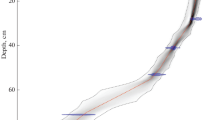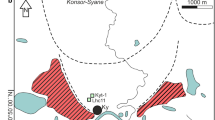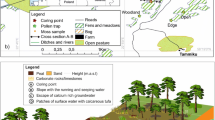Abstract
Our palaeoecological study covers 73 years of history (1929–2002) of a kettle hole peatland inundated by water from a nearby, dammed lake. Testate amoebae, pollen and non-pollen palynomorphs (NPPs) were used to track the shift to wetter conditions in the peatland. Lead-210 was used to try and construct the chronology. We investigated how peatland testate amoebae communities changed since the damming of a nearby river. Furthermore, we evaluated how rapidly local vegetation responded to the increase in wetness, and how vegetation changes correlated with shifts in testate amoebae and NPPs. The Mukrza kettle hole provided palaeoecological evidence of trophic state and hydrological changes since the lake filled with water in 1929. Three stages of development were revealed. The first two were associated with initial inundation, and the third was related to Sphagnum expansion and acidification. Quantitative reconstruction of groundwater level and pH, inferred using testate amoebae, confirmed our hypotheses about changes in hydrology and trophic state. Subfossil desmid remains lend qualitative support to the reconstruction. The ecology of several testate amoeba taxa is discussed in the context of succession and population establishment. There was complete species replacement since the time of inundation. Our investigation has two important applied aspects: (1) it enables prediction of the response of peatlands to a rise in water table on restored sites; and (2) it provides analogues for palaeoclimatological studies. The history of the Mukrza mire is an example of how palaeoecological studies can be used to assess the degree of change in peatlands transformed by human activities.







Similar content being viewed by others
References
Amesbury MJ, Charman DJ, Fyfe RM, Langdon PG, West S (2008) Bronze Age upland settlement decline in southwest England: testing the climate change hypothesis. J Archaeol Sci 35:87–98. doi:10.1016/j.jas.2007.02.010
Appleby PG (2001) Chronostratigraphic techniques in recent sediments. In: Last WM, Smol JP (eds) Tracking environmental changes using lake sediments Vol 2: basin analysis, coring, and chronological techniques. Kluwer, Dordrecht, pp 171–203
Appleby PO, Shotyk W, Frankhauser A (1997) Lead-210 age dating of three peat cores in the Jura Mountains, Switzerland. Water Air Soil Pollut 100:223–231. doi:10.1023/A:1018380922280
Belyea LR, Malmer N (2004) Carbon sequestration in peatland: patterns and mechanisms of response to climate change. Glob Change Biol 10:1043–1051
Berglund BE, Ralska-Jasiewiczowa M (1986) Pollen analysis and pollen diagrams. In: Berglund BE (ed) Handbook of Holocene paleoecology and paleohydrology. Wiley, Chichester, pp 455–484
Blundell A, Barber K (2005) A 2800-year palaeoclimatic record from Tore Hill Moss, Strathspey, Scotland: the need for a multi-proxy approach to peat-based climate reconstructions. Quat Sci Rev 24:1261–1277. doi:10.1016/j.quascirev.2004.08.017
Blundell A, Charman DJ, Barber K (2008) Multiproxy late Holocene peat records from Ireland: towards a regional palaeoclimate curve. J Quat Sci 23:59–71. doi:10.1002/jqs.1115
Booth RK (2007) Testate amoebae as proxies for mean annual water-table depth in Sphagnum-dominated peatlands of North America. J Quat Sci 23:43–57. doi:10.1002/jqs.1114
Booth RK, Jackson ST, Gray CED (2004) Paleoecology and high-resolution paleohydrology of a kettle peatland in upper Michigan. Quat Res 61:1–13. doi:10.1016/j.yqres.2003.07.013
Booth RK, Sullivan ME, Sousa VA (2008) Ecology of testate amoebae in a North Carolina pocosin and their potential use as environmental and paleoenvironmental indicators. Ecoscience 15:277–289. doi:10.2980/15-2-3111
Charman DJ (2002) Peatlands and environmental change. Wiley, Chichester, 301 pp
Charman DJ (2007) Summer water deficit variability controls on peatland water-table changes: implications for Holocene palaeoclimate reconstructions. Holocene 17:217–227. doi:10.1177/0959683607075836
Charman D, Blundell A (2007) A new European testate amoebae transfer function for palaeohydrological reconstruction on ombrotrophic peatlands. J Quat Sci 22:209–221. doi:10.1002/jqs.1026
Charman DJ, Hendon D, Woodland WA (2000) The identification of testate amoebae (Protozoa: Rhizopoda) in peats. Technical Guide No. 9. Quaternary Research Association, London, 147 pp
Charman D, Roe HM, Gerhels WR (2002) Modern distribution of saltmarsh testate amoebae: regional variability of zonation and response to environmental variables. J Quat Sci 17:387–409. doi:10.1002/jqs.703
Clarke KJ (2003) Guide to identification of soil protozoa—testate amoebae. Freshwater Biological Association, Ambleside, 40 pp
Erdtman G, Berglund BE, Praglowski J (1961) An introduction to a Scandinavian pollen flora. Grana Palynol 2:3–92
Escobar J, Brenner M, Whitmore TJ, Kenney WF, Curtis JH (2008) Ecology of testate amoebae (thecamoebians) in subtropical Florida lakes. J Paleolimnol 40:715–731. doi:10.1007/s10933-008-9195-5
Faegri K, Iversen J (1989) Texbook of pollen analysis. Wiley, Chichester, 328 pp
Flynn WW (1968) The determination of low-levels of polonium-210 in environmental materials. Anal Chim Acta 43:221–227. doi:10.1016/S0003-2670(00)89210-7
Gorham E, Rochefort L (2003) Peatland restoration: a brief assessment with special reference to Sphagnum bogs. Wetlands Ecol Manage 11:109–119. doi:10.1023/A:1022065723511
Grimm EC (1987) CONISS: a Fortran 77 program for stratigraphically constrained cluster analysis by the method of incremental sum of squares. Comput Geosci 13:13–35. doi:10.1016/0098-3004(87)90022-7
Grimm EC (1992) TILIA/TILIA graph. Version 1.2. Illinois State Museum, Springfield
Grospietsch T (1958) Wechseltierchen (Rhizopoden). Kosmos, Stuttgart, 86 pp
Heathwaite AL, Göttlich K (eds) (1993) Mires. Process, exploitation and conservation. John Wiley, Chichester, 506 pp
Hendon D, Charman DJ (1997) The preparation of testate amoebae (Protozoa: Rhizopoda) samples from peat. Holocene 7:199–205. doi:10.1177/095968369700700207
Hendon D, Charman D, Kent M (2001) Palaeohydrological records derived from testate amoebae analysis from peatlands in northern England: within-site variability, between-site comparability and palaeoclimatic implications. Holocene 11:127–148. doi:10.1191/095968301674575645
Jankovská V, Komárek J (2000) Indicative value of Pediastrum and other coccal green algae in palaeoecology. Folia Geobot 35:59–82. doi:10.1007/BF02803087
Joosten H, Clarke D (2002) Wise use of mires and peatlands—background and principles including a framework for decision-making. International Mire Conservation Group and International Peat Society, Saarijärvi, 304 pp
Juggins S (2003) C2 user guide. Software for ecological and palaeoecological data analysis and visualisation. University of Newcastle, Newcastle upon Tyne, 69 pp
Komárek J, Jankovská V (2001) Review of the green algal genus Pediastrum; implication for pollen-analytical research. Bibl Phycol 108:1–127
Kowalewski G (2001) Transformation of wetlands and lakes at the zone of influence of Koronowski Reservoir. Limnol Rev 1:165–172
Kowalewski G (2003) Przeobrażenia jezior i mokradeł w strefie oddziaływania Zbiornika Koronowskiego. Bogucki Wydawnictwo Naukowe, Poznań, 62 pp
Laggoun-Défarge F, Mitchell E, Gilbert D, Disnar JR, Comont L, Warner BG, Buttler A (2008) Cut-over peatland regeneration assessment using organic matter and microbial indicators (bacteria and testate amoebae). J Appl Ecol 45:716–727. doi:10.1111/j.1365-2664.2007.01436.x
Lamentowicz M, Mitchell EAD (2005a) The ecology of testate amoebae (Protists) in Sphagnum in north-western Poland in relation to peatland ecology. Microb Ecol 50:48–63. doi:10.1007/s00248-004-0105-8
Lamentowicz M, Mitchell EAD (2005b) Testate amoebae (Protists) as palaeoenvironmental indicators in peatlands. Pol Geol Inst Spec Pap 16:58–64
Lamentowicz M, Tobolski K, Mitchell EAD (2007) Palaeoecological evidence for anthropogenic acidification of a kettle-hole peatland in northern Poland. Holocene 17:1185–1196. doi:10.1177/0959683607085123
Lamentowicz Ł, Lamentowicz M, Gąbka M (2008a) Testate amoebae ecology and a local transfer function from a peatland in western Poland. Wetlands 28:164–175. doi:10.1672/07-92.1
Lamentowicz M, Cedro A, Miotk-Szpiganowicz G, Mitchell EAD, Pawlyta J, Goslar T (2008b) Last millennium palaeoenvironmental changes from a Baltic bog (Poland) inferred from stable isotopes, pollen, plant macrofossils and testate amoebae. Palaeogeogr Palaeoclimatol Palaeoecol 265:93–106. doi:10.1016/j.palaeo.2008.04.023
Lamentowicz M, Obremska M, Mitchell EAD (2008c) Autogenic succession, land-use change, and climatic influences on the Holocene development of a kettle hole mire in Northern Poland (Northern Poland). Rev Palaeobot Palynol 151:21–40. doi:10.1016/j.revpalbo.2008.01.009
Lamentowicz M, Milecka K, Gałka M, Cedro A, Pawlyta J, Piotrowska N, Lamentowicz Ł, van der Knaap WO (2009) Climate- and human-induced hydrological change since AD 800 in an ombrotrophic mire in Pomerania (N Poland) tracked by testate amoebae, macro-fossils, pollen, and tree-rings of pine. Boreas 38:214–229. doi:10.1111/j.1502-3885.2008.00047.x
Langdon PG, Barber KE (2005) The climate of Scotland over the last 5000 years inferred from multiproxy peatland records: inter-site correlations and regional variability. J Quat Sci 20:549–566. doi:10.1002/jqs.934
Mauquoy D, Engelkes T, Groot MHM, Markesteijn F, Oudejans MG, van der Plicht J, van Geel B (2002) High-resolution records of late-Holocene climate change and carbon accumulation in north-west European ombrotrophic peat bogs. Palaeogeogr Palaeoclimatol Palaeoecol 186:275–310. doi:10.1016/S0031-0182(02)00513-8
Mitchell E, Charman D, Warner B (2008a) Testate amoebae analysis in ecological and paleoecological studies of wetlands: past, present and future. Biodivers Conserv 17:2115–2137. doi:10.1007/s10531-007-9221-3
Mitchell EAD, Payne RJ, Lamentowicz M (2008b) Potential implications of differential preservation of testate amoebae shells for paleoenvironmental reconstruction in peatland. J Paleolimnol 40:603–618. doi:10.1007/s10933-007-9185-z
Moore PD, Webb JA, Collinson ME (1991) Pollen analysis. Blackwell Scientific Publication, Oxford, 216 pp
Ogden CGR, Hedley H (1980) An atlas of freshwater testate amoebae. British Museum (Natural History) and Oxford University Press (London and Oxford), London, 222 pp
Payne RJ, Mitchell EAD (2007) Ecology of testate amoebae from mires in the Central Rhodope Mountains, Greece and development of a transfer function for palaeohydrological reconstruction. Protist 158:159–171. doi:10.1016/j.protis.2006.11.003
Payne RJ, Pates JM (2009) Vertical stratification of testate amoebae in the Elatia Mires, northern Greece: palaeoecological evidence for a wetland response to recent climatic change, or autogenic processes? Wetlands Ecol Manage. doi:10.1007/s11273-008-9112-8
R Development Core Team (2006) R: A language and environment for statistical computing. R Foundation for Statistical Computing. URL http://www.R-project.org., Vienna, Austria
Roos-Barraclough F, van der Knaap WO, van Leeuwen JFN, Shotyk W (2004) A Late-glacial and Holocene record of climatic change from a Swiss peat humification profile. Holocene 14:7–19. doi:10.1191/0959683604hl685rp
Rydin H, Jeglum J (2006) The biology of peatlands. Oxford University Press, Oxford, 343 pp
Shotyk W, Cheburkin AK, Appleby PG, Frankhauser A, Kramers JD (1996) Two thousand on atmospheric arsenic, antimony, and lead deposition recorded in an ombrotrophic peat bog profile, Jura Mountains. Earth Planet Sci Lett 145:E1–E7. doi:10.1016/S0012-821X(96)00197-5
Sillasoo Ü, Mauquoy D, Blundell A, Charman D, Blaauw M, Daniell JRG, Toms P, Newberry J, Chambers FM, Karofeld E (2007) Peat multi-proxy data from Männikjärve bog as indicators of late Holocene climate changes in Estonia. Boreas 36:20–37. doi:10.1080/03009480600923360
ter Braak CJF, Šmilauer P (1998) CANOCO reference manual and user’s guide to Canoco for windows software for Canonical community ordination (version 4). Centre for Biometry, Wageningen, 352 pp
Tobolski K (2003) Torfowiska, na przykładzie Ziemi Świeckiej (Peatlands—an example of Świecie area). Towarzystwo Przyjaciół Dolnej Wisły, Świecie, 255 pp (in Polish)
Turetsky MR, Manning SW, Wieder RK (2004) Dating recent peat deposits. Wetlands 24:324–356. doi:10.1672/0277-5212(2004)024[0324:DRPD]2.0.CO;2
van der Linden M, Vickery E, Charman DJ, van Geel B (2008) Effects of human impact and climate change during the last 350 years recorded in a Swedish raised bog deposit. Palaeogeogr Palaeoclimatol Palaeoecol 262:1–31. doi:10.1016/j.palaeo.2008.01.018
Wanner M, Elmer M, Kazda M, Xylander WER (2008) Community assembly of terrestrial testate amoebae: How is the very first beginning characterized? Microb Ecol 56:43–54. doi:10.1007/s00248-007-9322-2
Weisse T (2008) Distribution and diversity of aquatic protists: an evolutionary and ecological perspective. Biodivers Conserv 17:243–259. doi:10.1007/s10531-007-9249-4
Weltzin JF, Harth C, Bridgham SD, Pastor J, Vonderharr M (2001) Production and microtopography of bog bryophytes: response to warming and water-table manipulations. Oecologia 128:557–565. doi:10.1007/s004420100691
Wilmshurst JM, McGlone M, Charman DJ (2002) Holocene vegetation and climate change in southern New Zealand: linkages between forest composition and quantitative surface moisture reconstructions from an ombrotrophic bog. J Quat Sci 17:653–666. doi:10.1002/jqs.689
Acknowledgments
This study was funded by a research grant from the Polish Ministry of Science and Higher Education (No. 2PO4G04929) (PI Milena Obremska). Mariusz Lamentowicz was funded by the above-mentioned grant as well as another grant from the Polish Ministry of Science and Higher Education (No. 2PO4G03228). We are indebted to Kazimierz Tobolski, and to Krystyna Milecka for inspiration and discussions. We thank David Wilkinson, Richard Payne and Mark Brenner for helpful remarks. We also thank Charlotte Vandenberghe and Sylwia Ufnalska for improving the English. Further funding to ML by Foundation for Polish Science (FNP) (Outgoing Fellowship KOLUMB) is acknowledged.
Author information
Authors and Affiliations
Corresponding author
Rights and permissions
About this article
Cite this article
Lamentowicz, M., Obremska, M. A rapid response of testate amoebae and vegetation to inundation of a kettle hole mire. J Paleolimnol 43, 499–511 (2010). https://doi.org/10.1007/s10933-009-9347-2
Received:
Accepted:
Published:
Issue Date:
DOI: https://doi.org/10.1007/s10933-009-9347-2




